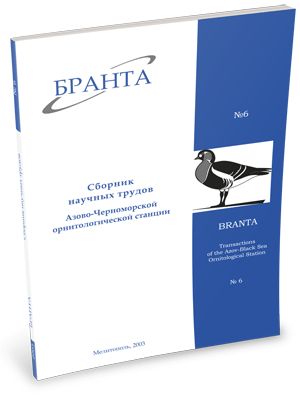
Transactions
of the Azov-Black Sea Ornithological Station



Estimation of qualitative diversity of the Coot feeding (Fulica atra) behaviour within Palearctic area of its range
Rezanov A.G.
Survey of the feeding behaviour of this species with wide geographic distribution allows gathering important data that is necessary to estimate both the species behavior in general and its ecological-geographic aspects together with microevoluntary ones (Rezanov, 2001, 2003). To do this study the Coot (Fulica atra) was chosen to be a model species, because it is observed within a wide geographical territory of Palearctic (Stepanyan, 2003) and demonstrates a high diversity of the feeding methods (Koshelev, 1984; Kurochkin, Koshelev, 1987; Rezanov, 2000, 2001; Cramp, Simmons, 1982).
Materials and Methods. Materials on the Coot (Fulica atra) feeding behaviour were collected during May-June 1983 and 1987 in Moscow region (Russia); in June 1989 in Zaporizhzhia region (Ukraine); in February 1995 and January 1996 in Krasnodar region (Russia). Estimation of the Coot feeding behaviour was taken according to the scheme of classifiers proposed by the author (Rezanov, 2000), which allows accessing the feeding method as many-parameter phenomenon.
The following classifiers have been selected: 1) surroundings of the forager, while searching the food; 2) a) locomotion which helps the bird to move into space, while searching the food; b) specialized locomotion and motor acts with a beak and legs to assist discovering the food; 3) locomotion of approaching the bird to its forage; 4) surroundings of approaching the bird to its discovered forage; 5) type of the contact with the foraging item when taking it; 6) surroundings of the foraging item location while it is being taken by the bird; 7) type of the foraging item (fixed or loose).
As a result of such a coding the feeding method is presented as a "chain " of figures, where each of the components can be compared with analogical components of other "chains".
Results and Discussion. Basing on the space location of both feeding bird and its potential prey for different feeding phases (searching and obtaining), the feeding methods are divided into several groups:
I. Group of land feeding methods (n=8). The bird searches and as usual obtains the forage on the land substrate. It is so-called “foot hunting". The coding of the feeding methods parameters is done using the system of classifiers (Rezanov, 2000).
II. Feeding methods, using in the shallow water (n-7). The bird searches and obtains the forage at the shoals, using the land type of locomotion - "foot hunting" at the shallow.
III. Searching and obtaining the forage while swimming (n-19). To obtain the forage while swimming, the bird moves remaining above the water.
IV. Underwater searching and obtaining the forage (n=3). The bird dives when swimming, and further searching is taken beneath the water surface.
Estimation of both differences and similarity in the feeding methods of the Coot. Both differences and similarity level in feeding methods of the Coot was estimated using the cluster analysis by the single linkage method and Ward's method (Fig.1-2). Aggregation of the feeding methods into clusters has been done basing on matching or non-matching of the figure codes for all seven parameters used to estimate the feeding methods.
Estimation of the relation between the Coot feeding methods (geographic-ecological aspect). Though the certain feeding method is usually connected with the certain point of geographic space this fact itself does not provide any basement for classification of the feeding methods according to a geographic principle. Observations of the bird feeding behaviour, taken at the same water body but in different days, frequently showed a considerable divarication in the relation between using feeding methods. This divarication may even exceed so-called "geographic" ones.
According to these facts some dendrograms of geographic "points" divarication have been built for the Coot feeding methods (Fig. 3-4).
Read the paper in a PDF file